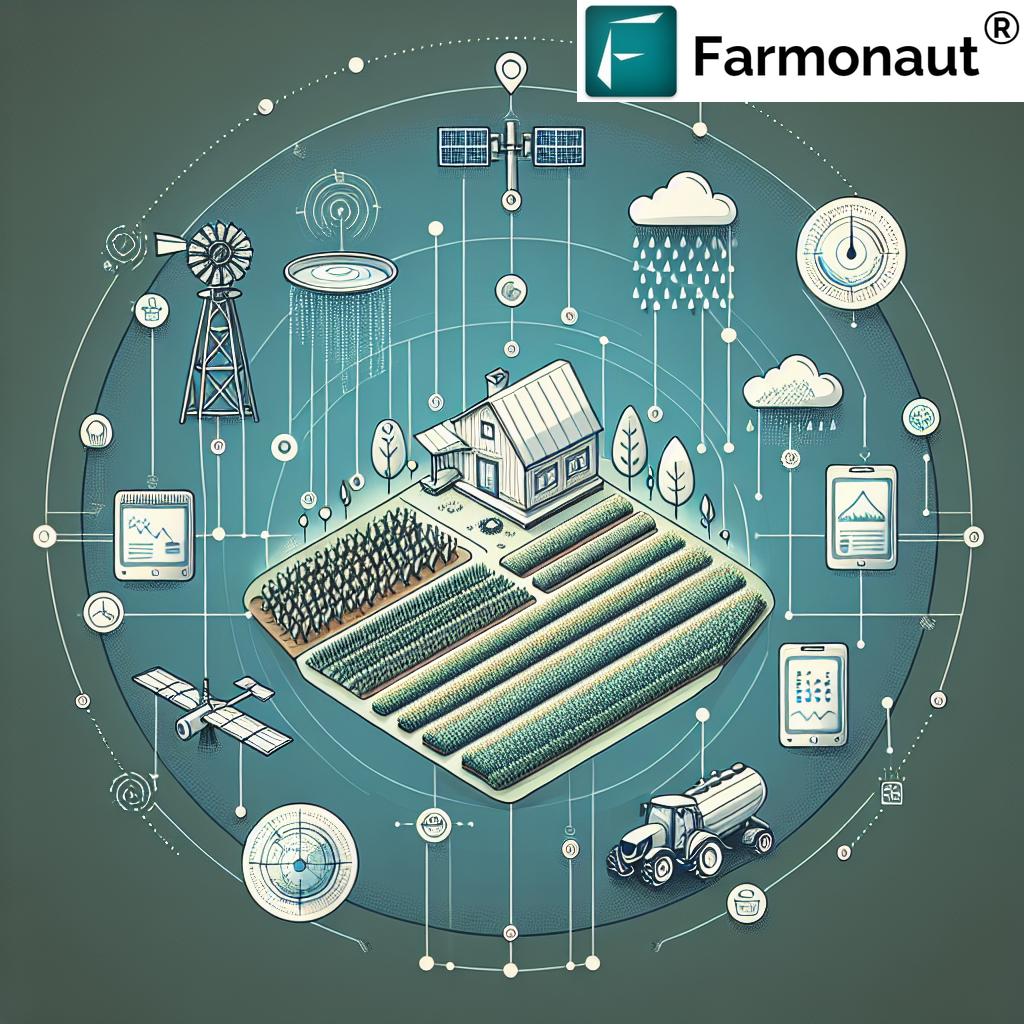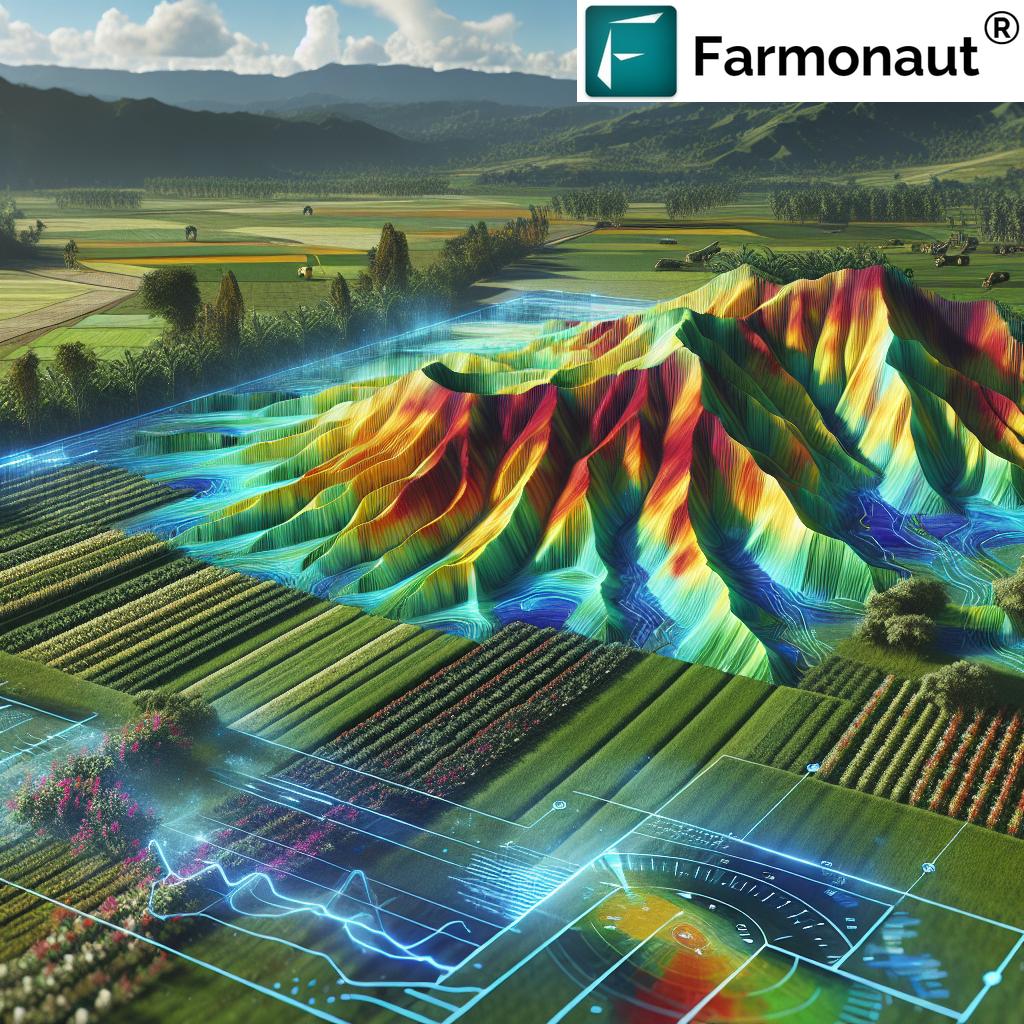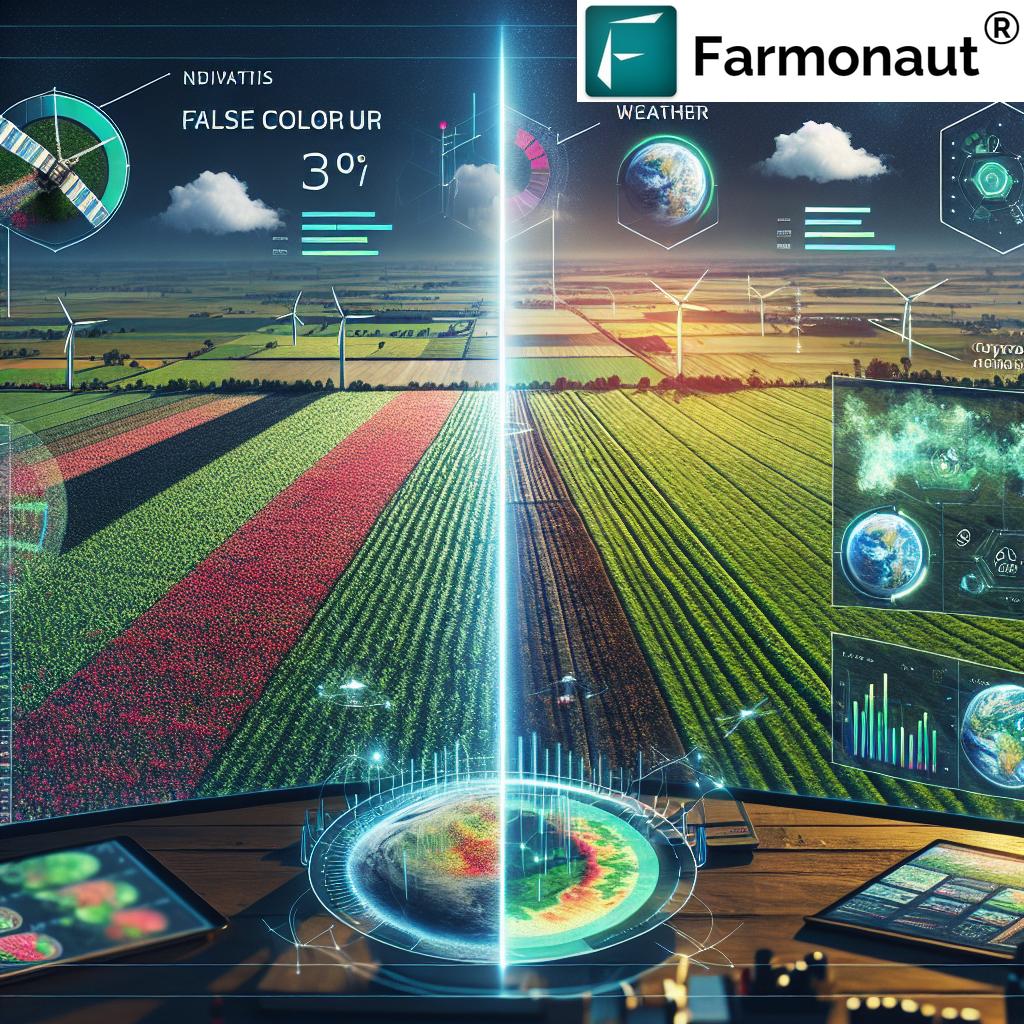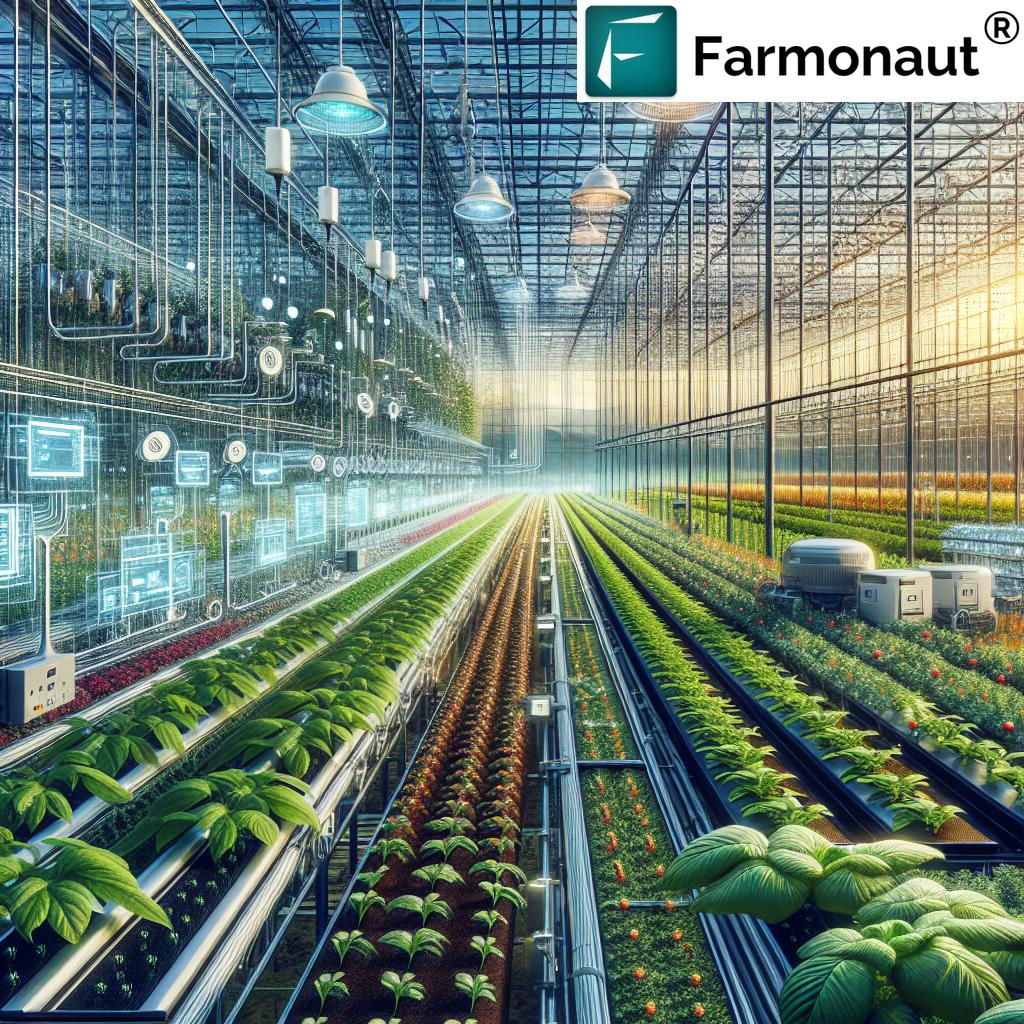Optimizing Farm Management: Leveraging Rainfall Data and Weather Forecasts for Improved Agricultural Decision-Making

In the ever-evolving world of agriculture, we at Farmonaut understand the critical role that accurate weather data and rainfall measurements play in optimizing farm management. As pioneers in agricultural technology, we’re committed to providing farmers with the tools they need to make informed decisions and maximize their crop yields. In this comprehensive guide, we’ll explore how leveraging rainfall data and weather forecasts can revolutionize your farming practices and lead to improved agricultural decision-making.
The Importance of Rainfall Data in Agriculture
Rainfall is a fundamental factor in agricultural success, directly impacting crop growth, soil health, and overall farm productivity. Accurate rainfall data is essential for:
- Irrigation planning
- Fertilizer application timing
- Pest and disease management
- Harvest scheduling
- Crop selection and rotation
Traditionally, farmers have relied on rain gauges to measure precipitation. While these tools have served the agricultural community well, they have limitations in providing comprehensive, real-time data across large areas. This is where modern technology, such as satellite-based rainfall monitoring systems, comes into play.
Satellite-Based Rainfall Monitoring vs. Traditional Rain Gauges
Let’s compare the capabilities of satellite-based rainfall monitoring systems, like those offered by Farmonaut, with traditional rain gauges:
| Feature | Satellite-Based Monitoring | Traditional Rain Gauges |
|---|---|---|
| Accuracy | High precision with field-level data | Localized accuracy, limited by gauge placement |
| Coverage Area | Large-scale, covering entire farms or regions | Limited to specific gauge locations |
| Data Frequency | Real-time updates | Manual readings, often daily or less frequent |
| Compatibility with Variable Rate Applications | Fully integrated with precision farming tools | Limited integration capabilities |
As you can see, satellite-based monitoring offers significant advantages in terms of accuracy, coverage, and data frequency. These benefits translate directly into more informed decision-making for farmers.
Leveraging Weather Forecasts for Proactive Farm Management
While historical rainfall data is crucial, the ability to anticipate future weather conditions is equally important for proactive farm management. Advanced weather forecasting technologies allow farmers to:
- Plan planting and harvesting activities
- Prepare for potential extreme weather events
- Optimize irrigation schedules
- Adjust fertilizer and pesticide applications
- Make informed decisions about crop protection measures
At Farmonaut, we integrate cutting-edge weather forecasting models with our satellite-based monitoring systems to provide farmers with comprehensive climate insights. This holistic approach enables more precise and timely agricultural decision-making.
The Role of Data Analysis in Agricultural Meteorology
Raw weather data and rainfall measurements are valuable, but their true power is unlocked through sophisticated data analysis. Our team of agricultural meteorologists and data scientists work tirelessly to interpret complex weather patterns and translate them into actionable insights for farmers.
Some key aspects of our data analysis include:
- Rainfall variability assessment: Understanding how precipitation patterns vary across different fields and over time.
- Climate trend analysis: Identifying long-term climate shifts that may impact crop selection and farming practices.
- Extreme weather event prediction: Forecasting the likelihood and potential impact of severe thunderstorms, tornadoes, and other weather phenomena.
- Soil moisture modeling: Combining rainfall data with soil characteristics to estimate moisture levels and inform irrigation decisions.
- Crop-specific weather impact analysis: Assessing how different weather conditions affect various crops at different growth stages.
Integrating Rainfall Data into Farm Management Systems
To maximize the value of rainfall data and weather forecasts, it’s essential to integrate this information into broader farm management systems. Farmonaut’s platform offers seamless integration capabilities, allowing farmers to:
- Visualize rainfall patterns and weather data alongside other critical farm metrics
- Generate custom reports and alerts based on specific weather thresholds
- Automatically adjust irrigation systems based on real-time rainfall data and forecasts
- Optimize variable rate applications of fertilizers and pesticides using precise weather information
- Track and analyze the relationship between weather patterns and crop yields over time
By connecting weather data with other aspects of farm management, farmers can make more holistic and informed decisions about their operations.

The Impact of Accurate Rainfall Estimates on Crop Health
Precise rainfall estimates play a crucial role in maintaining optimal crop health throughout the growing season. Here’s how accurate precipitation data contributes to various aspects of crop management:
1. Irrigation Management
With precise rainfall estimates, farmers can fine-tune their irrigation schedules, ensuring that crops receive the right amount of water at the right time. This not only promotes healthy plant growth but also conserves water resources and reduces irrigation costs.
2. Disease Prevention
Many crop diseases thrive in high-moisture environments. By monitoring rainfall patterns and humidity levels, farmers can anticipate potential disease outbreaks and take preventive measures, such as applying fungicides or adjusting planting densities.
3. Nutrient Management
Rainfall can affect the availability and movement of nutrients in the soil. Accurate precipitation data helps farmers optimize their fertilizer application timing and rates, ensuring that nutrients are available when crops need them most while minimizing runoff and environmental impact.
4. Harvest Planning
Rainfall patterns leading up to harvest can significantly impact crop quality and yield. By leveraging precise rainfall data and forecasts, farmers can make informed decisions about harvest timing to maximize crop quality and minimize potential weather-related losses.
Advanced Technologies for Rainfall Measurement and Forecasting
At Farmonaut, we employ a range of cutting-edge technologies to provide the most accurate and comprehensive rainfall data and weather forecasts possible. Some of the key technologies we utilize include:
1. Satellite-Based Precipitation Radar
Our advanced satellite systems use precipitation radar to measure rainfall across vast areas with high precision. This technology allows us to generate detailed rainfall maps and estimates for every field, even in remote locations.
2. Machine Learning Algorithms
We use sophisticated machine learning models to analyze historical weather patterns, current atmospheric conditions, and other relevant data points to generate highly accurate short-term and long-term weather forecasts.
3. IoT-Enabled Weather Stations
In addition to satellite data, we integrate information from a network of IoT-enabled weather stations to provide hyper-local weather insights. These ground-based sensors complement our satellite data, enhancing the overall accuracy of our weather models.
4. High-Resolution Atmospheric Modeling
Our team of meteorologists employs advanced atmospheric models to simulate weather patterns and predict future conditions. These models take into account complex factors such as topography, land use, and atmospheric dynamics to provide highly accurate forecasts.
Leveraging Rainfall Data for Sustainable Farming Practices
Accurate rainfall data and weather forecasts are not only crucial for optimizing crop yields but also play a significant role in promoting sustainable farming practices. Here’s how farmers can use this information to enhance their environmental stewardship:
1. Water Conservation
By precisely tracking rainfall and soil moisture levels, farmers can implement more efficient irrigation strategies, reducing water waste and conserving this precious resource.
2. Erosion Control
Understanding rainfall patterns and intensities allows farmers to implement targeted erosion control measures, such as contour plowing or cover cropping, in areas most susceptible to soil loss.
3. Reduced Chemical Runoff
Accurate precipitation forecasts enable farmers to time their fertilizer and pesticide applications to minimize the risk of runoff during heavy rainfall events, protecting local water sources and ecosystems.
4. Carbon Sequestration
By optimizing crop growth through precise water and nutrient management, farmers can increase biomass production and enhance soil organic matter, contributing to carbon sequestration efforts.
The Economic Impact of Improved Weather-Based Decision Making
Implementing advanced rainfall monitoring and weather forecasting technologies can have a significant positive impact on a farm’s bottom line. Let’s explore some of the economic benefits:
1. Increased Crop Yields
By making data-driven decisions about planting, irrigation, and harvest timing, farmers can optimize growing conditions and maximize crop yields.
2. Reduced Input Costs
Precise weather data allows for more efficient use of resources such as water, fertilizers, and pesticides, leading to reduced input costs without sacrificing crop health or yields.
3. Minimized Crop Losses
Accurate weather forecasts and early warning systems for severe weather events help farmers take proactive measures to protect their crops, reducing potential losses due to extreme weather conditions.
4. Improved Market Timing
Understanding weather patterns and their impact on crop development can help farmers better predict harvest timing and quality, allowing for more strategic marketing and selling of their produce.
5. Enhanced Risk Management
Comprehensive weather data and analysis support better risk assessment and management, potentially leading to more favorable insurance terms and reduced premiums for farmers.
Integrating Rainfall Data with Other Precision Agriculture Technologies
To maximize the benefits of accurate rainfall data and weather forecasts, it’s essential to integrate this information with other precision agriculture technologies. At Farmonaut, we’ve designed our platform to seamlessly connect with a wide range of farming tools and technologies, including:
1. Variable Rate Technology (VRT)
Our rainfall data and soil moisture estimates can be used to inform variable rate irrigation and fertilizer application systems, ensuring that each part of the field receives the optimal amount of water and nutrients based on its specific conditions.
2. Drone and Satellite Imagery
By combining rainfall data with aerial imagery of crop health and development, farmers can gain a more comprehensive understanding of how weather patterns are impacting their fields and make more informed management decisions.
3. Soil Sensors
Integrating data from in-field soil moisture sensors with our satellite-based rainfall estimates provides an even more accurate picture of soil water content, enabling precise irrigation management.
4. Farm Management Software
Our weather data and insights can be seamlessly integrated into broader farm management platforms, allowing farmers to view rainfall information alongside other critical metrics such as crop yields, input costs, and market prices.
5. Automated Equipment
Advanced farming equipment, such as self-driving tractors and robotic harvesters, can use our weather data to optimize their operations, adjusting their activities based on current and forecasted conditions.
The Future of Weather-Based Farm Management
As technology continues to advance, the future of weather-based farm management looks incredibly promising. At Farmonaut, we’re continuously innovating to stay at the forefront of this evolution. Some exciting developments on the horizon include:
1. Hyper-Local Weather Prediction
Advancements in satellite technology and data processing will enable even more precise weather forecasts at the individual field level, allowing for micro-climate management.
2. AI-Powered Decision Support
Artificial intelligence and machine learning algorithms will become increasingly sophisticated, providing farmers with highly personalized recommendations based on weather data, crop genetics, and historical performance.
3. Real-Time Crop Stress Detection
By combining weather data with advanced crop monitoring technologies, we’ll be able to detect and alert farmers to potential crop stress conditions in real-time, enabling rapid response and intervention.
4. Climate Change Adaptation Tools
As global climate patterns continue to shift, we’re developing advanced modeling tools to help farmers adapt their practices and crop selections to changing long-term weather trends.
5. Blockchain-Enabled Weather Data Sharing
We’re exploring the use of blockchain technology to create secure, decentralized networks for sharing weather data among farmers, researchers, and other stakeholders, fostering greater collaboration and innovation in the agricultural sector.
Conclusion: Empowering Farmers with Weather Intelligence
In the complex world of modern agriculture, accurate rainfall data and weather forecasts have become indispensable tools for successful farm management. By leveraging advanced technologies and data analysis techniques, we at Farmonaut are committed to providing farmers with the weather intelligence they need to make informed decisions, optimize their operations, and build more resilient and sustainable farming practices.
As we look to the future, the integration of precise weather data with other precision agriculture technologies promises to revolutionize farming even further. By staying at the forefront of these innovations, we aim to continue empowering farmers worldwide to meet the growing global demand for food while adapting to the challenges of a changing climate.
To experience the power of data-driven farm management for yourself, we invite you to explore our comprehensive suite of agricultural technology solutions. Visit Farmonaut’s web application or download our mobile app for Android or iOS to start optimizing your farm management today.
For developers interested in integrating our weather data and insights into their own applications, check out our API documentation to learn more about our powerful satellite weather API.
FAQs
1. How accurate are satellite-based rainfall estimates compared to traditional rain gauges?
Satellite-based rainfall estimates have become increasingly accurate in recent years, often matching or exceeding the precision of traditional rain gauges. While specific accuracy can vary depending on factors such as terrain and storm intensity, our satellite-based system typically provides estimates within 10-15% of ground-based measurements, with the added advantage of covering large areas and providing real-time data.
2. Can Farmonaut’s weather forecasting system predict severe weather events like thunderstorms or tornadoes?
Yes, our advanced weather forecasting system incorporates models specifically designed to predict severe weather events, including thunderstorms and tornadoes. While no system can guarantee 100% accuracy in predicting these complex phenomena, our forecasts provide valuable early warnings that can help farmers prepare for and mitigate potential impacts.
3. How often is the rainfall data updated in Farmonaut’s system?
Our satellite-based rainfall monitoring system provides near-real-time updates, with new data typically available every 30 minutes to 1 hour, depending on satellite coverage and atmospheric conditions. This frequent updating ensures that farmers have access to the most current information for their decision-making processes.
4. Can Farmonaut’s weather data be integrated with my existing farm management software?
Absolutely! We’ve designed our system with integration in mind. Our API allows for seamless connection with a wide range of farm management software platforms. If you’re using a specific software that isn’t currently integrated, our development team can work with you to create a custom integration solution.
5. How does Farmonaut’s weather data help with variable rate applications?
Our precise rainfall data and soil moisture estimates can be used to inform variable rate irrigation and fertilizer application systems. By providing field-level insights into water availability and soil conditions, our data helps farmers optimize their input applications, ensuring that each part of the field receives the right amount of water and nutrients based on its specific needs.
6. Is Farmonaut’s weather data available for international locations?
Yes, our satellite-based system provides global coverage, allowing us to offer weather data and insights for agricultural regions worldwide. The specific level of detail and frequency of updates may vary slightly depending on the location, but we strive to provide comprehensive coverage for all major agricultural areas.
7. How can I learn to interpret and use the weather data provided by Farmonaut effectively?
We offer a range of resources to help farmers make the most of our weather data, including user guides, video tutorials, and webinars. Additionally, our support team is always available to provide personalized assistance and answer any questions you may have about interpreting and applying the data to your specific farming situation.
8. Does Farmonaut offer historical weather data for long-term trend analysis?
Yes, we maintain an extensive database of historical weather data, allowing farmers to analyze long-term trends and patterns. This historical data is invaluable for understanding climate shifts, planning crop rotations, and making informed decisions about long-term farm management strategies.
9. How does Farmonaut ensure the privacy and security of farm-specific weather data?
We take data privacy and security very seriously. All farm-specific data is encrypted and stored securely in accordance with industry best practices. We never share individual farm data without explicit permission, and our systems are regularly audited to ensure compliance with data protection regulations.
10. Can Farmonaut’s weather forecasting system account for microclimates within a single farm?
While our current system provides highly accurate field-level data, we are continually working to improve our resolution and ability to detect microclimates. For farms with known microclimates, we can work with you to incorporate additional data sources or ground-based sensors to enhance the precision of our forecasts for those specific areas.













